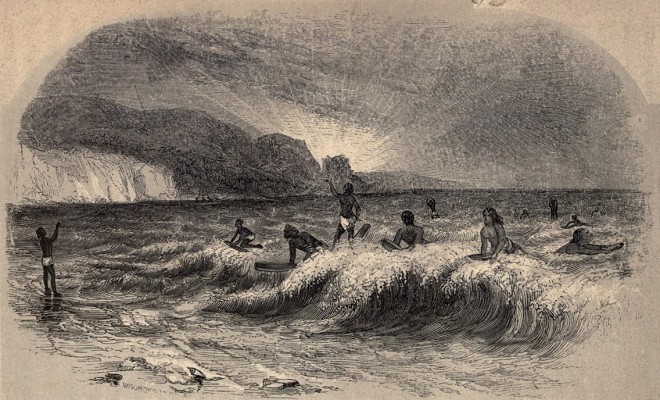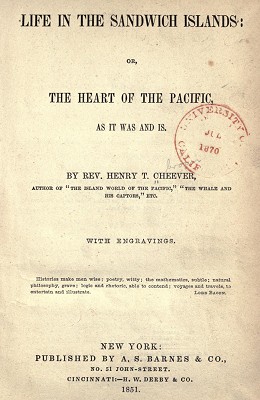 |
surfresearch.com.au
cheever : surfriding, maui 1851 |
| home | catalogue | history | references | appendix |
|
Open Library
http://openlibrary.org/books/OL7181319M/Life_in_the_Sandwich_Islands
Extracts from Cheever's
book, including the surf riding text and illustration, were included in
a book review, titled "The Sandwich Islands Today" in
The
International Monthly Magazine of Literature, Science and Art,
October 1851.
This was the first
time a surfing illustration was published in a magazine.
See
IMMLSA, below.
The book was published
concrrently by Richard Bentley in London in 1851, and a second edition
was published by A.S. Barnes in 1856.
In July 1858, Cheever's
1851 account and illustration reproduced in Hutchings' Illustrated California
Magazine,
Volume 3 Number 1.
See:
1858 Rev. Henry
Cheever : Our Neighbours
of the Sandwich Isles.
See also:
1851 Rev. Henry Cheever : Surf
Riding at Hilo.
Extract from The
Island World of the Pacific, Harper & Brothers Publishers, New
York, 1851, page 164.
It is highly amusing
to a stranger to go out into the south part or this town (Lahaina,
Maui),
some day when the sea is rolling
in heavily over the reef, and to observe there the evolutions and rapid
career of a company of surf-players.
The sport is
so attractive and full of wild excitement to Hawaiians, and withal so healthful,
that I cannot but hope it will be many years before civilization shall
look it out of countenance, or make it disreputable to indudge in this
manly, though it be dangerous, exercise.
Many a man from
abroad who has witnessed this exhilarating play, has no doubt idly wished
that he were free and able to share in it himself.
For my ...
Page 67
... part, I should like nothing better, if Icould do it, than to get balanced on a board just before a great rushing wave, and so be hurried in half or quarter of a mile landward with the speed of a race-horse, all the time enveloped in foam and spray, but without letting the roller break and tumble over my head.
In this consists
the strength of muscle and sleight-of-hand, to keep the head and shoulders
just ahead and clear of the great crested wall that is every moment impending
over one, and threatening to bury the bold surf-rider in its warery ruin.
The natives do
this with admirable intrepidity and skill, riding in, as it were, upon
the neck and mane of their furious charger; and when you look to see them,
their swift race run, dashed upon the rocks or sand, behold, they have
slipped under the belly of the wave they rode, and are away outside, waiting
for a cruise upon another.
Both men and women,
girls and boys, have their times for this diversion.
Even the huge
Premier (Auhea) has been kllown to commit her bulky person to a
surf-board; and the chiefs generally, when they visit Lahaina, take a turn
or two at this invigorating sport with billows and board.
For a more accurate
idea of it than can be conveyed by any description, the reader is referred
to the engraving.
I have no doubt it would num away with dyspesia from many a bather at Rockaway or Easthampton, if they would learn, and dare to use a surf-board on those great Atlantic rollers, as the Hawiians do on the ...
Page 68
... waters of
the Pacific.
But there is
wanting on the Atlantic sea-board that delicious, bland temperature of
the water, which within the tropics, while it makes sea-bathing equally
a tonic, renders it always safe.
The missionaries
at these Islands, and foreigners generally, are greatly at fault in that
they do not avail themselves more of this easy and unequalled means of
retaining health, or of restoring it when enfeebled.
Bathing in fresh
water, in a close bath-house, is not to be compared to it as all invigorating
and remedial agent; and it is unwise, not to say criminal, in such a climate,
to neglect so natural a way of preserving health, as washing and swimming
in the sea.
In those who
live close to the water, and on the leeward side of the islands, it is
the more inexcusable, for it could be enjoyed without exposure in the dewless
evenings; or in some places, a small house might be built on stone abutments
over the water, and facilities so contrived that both sexes could enjoy
this great luxury of life within the tropics.
Page 68
But we come back
to Lahaina, to speak of a charming grove of young cocoanut-trees in the
northwestern part of the town, planted by the excellent chief Hoapili,
or Hoapiliwahine.
They are not
the tall, lank, ghostly-looking things which the full grown tree is, that
becomes at these islands, fom the places in which you most often see it,
a synonym of desolation and sterility, but a luxuriant, youthful growth,
more beatuiful than ...
Facing Page 68

HAWAIIAN SPORT OF SURF PLAYING
... any thing in thc form of woods that I have seen since leaving America.
Six or seven
years ago there was a fine grove of large green Kou (Koa?)trees
in the opposite part of the town, near where the King lives, covering an
acre and a half or two acres, and so ancient and shady as to afford ample
covering for all the canoes in Lahaina, and all the people too.
But before any
one knew it, and not until it was too late to remonstrate against such
a piece of savagism, the King took a freak (?) to have them all
cut down to make into bowls, and spittoons, and pounding-boards for
'kalo'.
Could the outraged
trees have wept like the sacred grove in the Aenead, they could have
dropped tears of blood at the indignity.
So, on the island
of Molokni, there was a fine forest of Kamani-trees, the only ones at the
Islands.
It is a tree
of slow growth, and of great value for its beautlful wood.
But the chiefs
a few years ago had them all mercilessly cut down, without any care to
propagate young ones, happening to want the timber to repair some vessels.
It was a fair
specimen of ordinary barbarism: how unlike the wisdom of Kamehameha the
Great, who, when binis were ctaught for him to pluck certain feathers for
his 'leis' and 'kaahilis', would not let them be killed,
but set loose again, to give feathers, he said to his sons.
And when they
cut young sticks of sandal-woodd, he remonstrated with them, and said,
"Is it, indeed, that you do not know my sons? To them the youug sandal-wood
belongs.''
 |
Life in the Sandwich Islands, or the Heart of the Pacific, as it was and as it is. A.S. Barnes and Co., New York, 1851. Open Library
|
The review begins:
"WHATEVER may be said of the influence of European and American profligacy in the Islands, they may be pointed to with perfect satisfaction for illustrations of the benefits of Christian civilization, and the people of this country are greatly indebted to the Rev. Henry T. Cheever, whose works on the subject we have had frequent occasion to praise, for the eminently judicious and interesting accounts he has given us of society, manners, and religion, and of industrial resources, and every kind of natural phenomena, throughout the " island world," especially in the Sandwich Islands, to which his last work* is altogether devoted." -page 298.
The surf riding passages are preceded by:
"The work abounds
with interesting details of Island Life, and we regret that our limitations
will not let us enrich the International with more liberal extracts.
We can at present
add but the following patragraphs on a sport for which the islanders have
been celebrated since the days of Cook:"
-pages 298-299
 |
The International Monthly Magazine of Literature, Science and Art. Volume IV, August to December, 1851 Stringer and Townsend, New York. googlebooks.com
|

| home | catalogue | history | references | appendix |